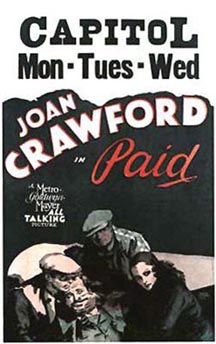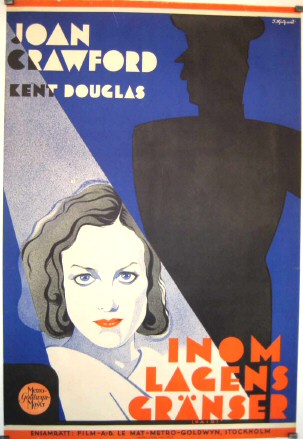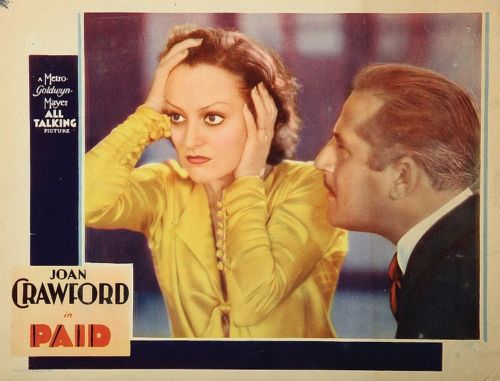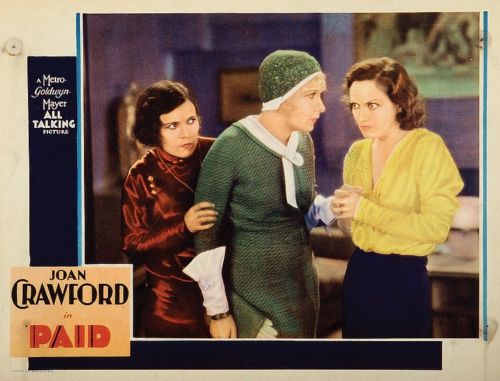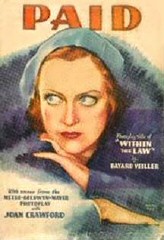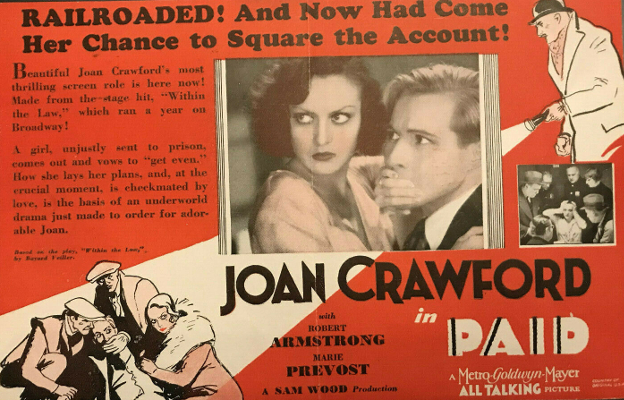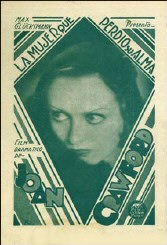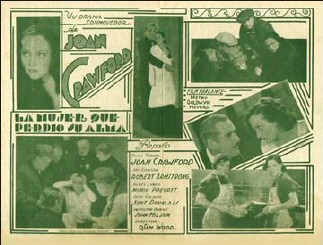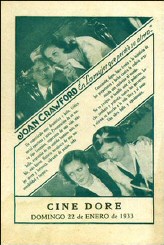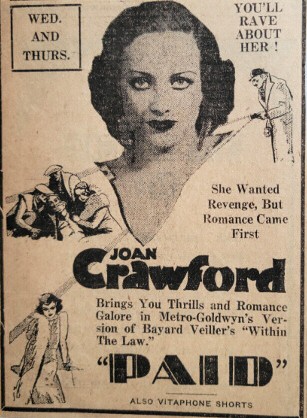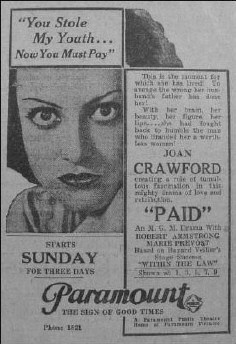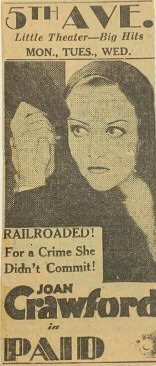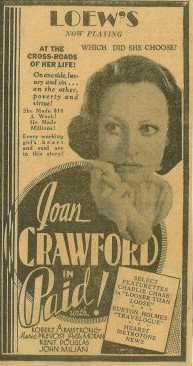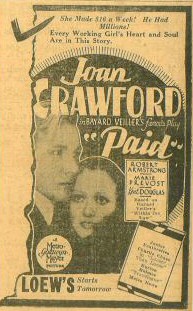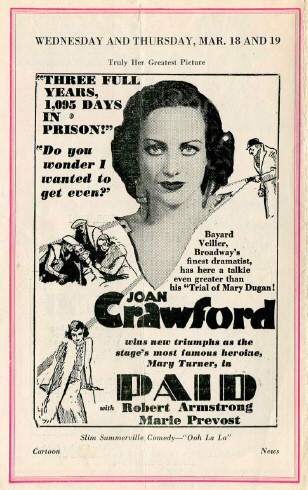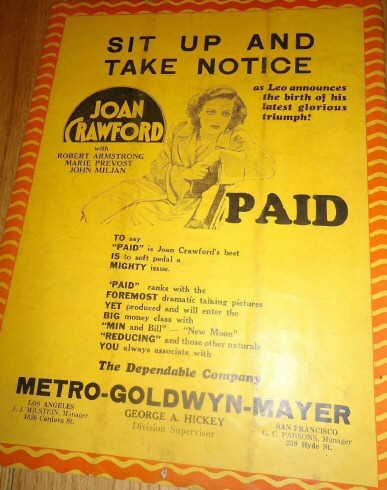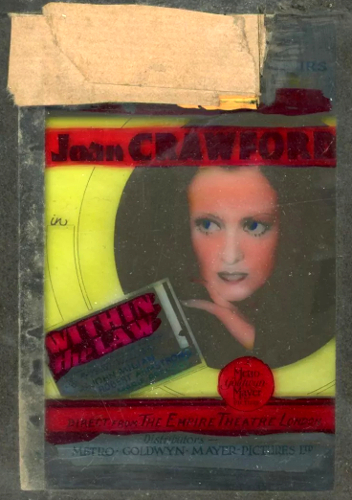 Stephanie Jones
(November 2022) Stephanie Jones
(November 2022)
Rating:    -1/2 of 5 -1/2 of 5
Given
the progressive "corrupt powers-that-be" theme of
this film (back when "progressive" and "speaking
truth to power" were a GOOD thing and not the travesty
of Marxism imposed upon us post-2016) and Joan's very good
performance in her first dramatic role, I almost gave this 4 stars,
but had to pull back slightly primarily because of the last half-hour or
so of the film, which devolved into a hackneyed "theft
of the Mona Lisa" plot and got a bit tedious and repetitive.
(The film is listed at 86 minutes, but my 2010 Warners Archive DVD
version ran on for almost a solid 2 hours/120 mins.)
Joan
plays "Mary Turner," a shop-girl falsely accused of theft
by the owner of the store where she worked, who refuses to show
her mercy at her sentencing. When she gets 3 years in prison (after
being represented by a young, inexperienced attorney), she promises
intensely as she's hauled away: "You're
going to pay me for everything I'm losing in life!"
Joan is great in this opening trial scene, with her scrubbed, gaunt face
and glowing eyes rimmed with black hollows. It's a precursor to
an even-more powerful scene in 1932's Rain when she condemns
the Reverend Davidson.
Equally
well-done are the brief, compelling prison scenes that follow, with
their quick cuts among some of the motley crew Mary is thrown
in with. And for a 1930 white audience, I'm sure a white woman having
to shower with -- gasp! -- a black woman might have been considered
especially degrading, though the uncredited Louise Beavers is friendly
and funny: "Don't
worry, honey. It all goes down the drain."
In
prison while shoveling slop, Mary meets "Aggie" (Marie
Prevost), whose criminal gang Mary ultimately joins up with
once released from prison, given no other chance for survival. The
comic Aggie and gang-boss Joe (Robert Armstrong), et al, are all
fair-play fellows. Mary initially offers to sleep with Joe (pre-Code,
you know), but he declines, because he realizes she's not really
a floozy. But, as it turns out, Mary has something to contribute:
While in prison, she studied the law: She wants revenge on her old
boss, but has learned the legal niceties of blackmailing, etc.,
that are all "within the law," which she is willing to
share with her new gang. First up is the blackmailing of a general
(with the 30-ish Aggie posing as a 14-year-old), followed by...Mary
intentionally hooking up with the playboy son of the store
owner who had her jailed. Bob Gilder (Kent Douglass) is a rather
naive rich boy whom Mary first disdains but also actually loves.
The
son is only a key to the main theme of the film: The corruption
of the police and District Attorney, who are beholden to their moneyed
interests rather than to Truth and Justice. In 1930, there
wasn't yet such a thing as "Noir," but this film is
definitely a forerunner to that dark genre---as well as being a
call to social justice (again, not in the false way being promoted
in the media post-2016, but for actual social justice). In this film,
the rich store-owner father blatantly pays
off the District Attorney and his inspectors to harrass people at
will, even when not warranted. Mary's gang, for instance, is only
hounded by the law because the father wants to keep her away from his
son. Once it's revealed that she's paid for a very high-priced lawyer,
the District Attorney and the police slink off.
Amid
this early Noir/Social Justice theme is Joan, with her initial jail-bird
gaunt persona, and then her post-jail be-gowned, be-jeweled, be-furred
persona. She's beautifully defiant in both roles. Aside from the
initial courtroom scene, she's also especially attractive and persuasive in
the scene where she arrives for a party with son Bob at his father's
house. Her new glamorous look has changed so much post-jail that the father doesn't
recognize her. When she identifies herself, she's immediately surrounded
by the father, DA, police inspector, and sergeant, who all barrage
her with accusations. She, solo amid their onslaught, is completely
cool and collected and returns their harsh volleys---not just a
script thing but also an ability of the actress involved. Just one
scene later, she's attacked again, with the DA accusing: "She
didn't even get time off for good behavior!"
To which Mary replies: "No,
and I'm proud of it. Do you realize what goes on behind stone walls?"
Joan,
for the first time, plays a serious grown woman here. Not a side-piece,
not a party girl. But a real woman confronted with real problems.
Aside from the usual early mouth contortions, which are somewhat
contained here, she's both moving and subtle, especially in her
scenes with the young Bob Gilder, when she's portraying feelings
of both love and desire for revenge. And the confrontation scenes
are just plain moving and near-great. Director Sam Wood also offers
us many close-ups of Joan's beautiful, very interesting face. Not
just looking pretty, but also in intense mode. (Up to this point,
I'd seen Garbo, et al, in full-screen "languishing" mode,
but no one ever looking disgruntled!)
As
I said above, the last half-hour of the film devolves into a rather
stereotypical and tedious "art theft and shootout and interrogation"
series of events, which seemed to go on way too long. "Who
shot who," etc., didn't really seem to be the point of the
film, aside from more fully emphasizing the corruption of the DA's
office.
And
I just have to mention: Near the end of the film, there's a brief
scene where Joan's Mary is being interrogated. Mary says: "Would
you please take that light out of my eyes---it's driving me crazy!"----Said
Joan NEVER! :)
 Tom
C. (September
2022) Tom
C. (September
2022)
Rating:     of 5 of 5
As much as I love her early work, Joan Crawford is not the
first name that springs to mind when I think of pre-Code actresses. Barbara
Stanwyck, Kay Francis, Miriam Hopkins, a young Carole Lombard before her talent
for screwball comedy was discovered, or even Helen Twelvetrees --- yes. JC? Not so
much. Perhaps it’s because my mind tends to equate MGM with glitz and glamour
productions rather than the gritty, booze- and crime-riddled plots that
proliferated in the period between the advent of talkies in the late 1920s and
full enforcement of the Motion Picture Production Code on July 1, 1934.
Paid (1930), however,
is quintessential pre-Code. Joan is Mary Turner, a shopgirl sent up
the river for 3 years for a crime she did not commit. While in the
pen, she studies the law and after her release, Joan/Mary teams up
with a bunch of shady characters to form an extortion racket. The crew
preys on old codgers with an eye for young ladies, and although blackmail,
everything is technically “within the law” --- the name of the play
by Bayard Veiller that is the source material for Paid. “Within
the Law” can be found online via Project Gutenberg; I found that reading
it helped fill in some aspects of the movie that I did not follow upon
my initial viewing of Paid.
One can easily imagine the surprise of her fans when Joan
first appears a few minutes into Paid, in the excellent opening court
scene. Joan is made up plainly, clad in homespun clothes, and is dragged from
the courtroom spewing venom at her unfeeling accusers, vowing to get even with
them. As America and the world settled into the first year of the Great Depression,
one assumes that Mary’s struggle against the establishment resonated well with
the audience. Indeed, Paid was a huge financial success for MGM.
Paid has a great team
behind the scenes. Perhaps because it was originally slated to be a Norma Shearer
flick? Cedric Gibbons does the sets, Sam Wood (Pride of the Yankees, Goodbye,
Mr. Chips, Beyond the Rocks ---
the only film pairing of Swanson and
Valentino) directs, Douglas Shearer --- Norma’s bro --- did the sound.
Charles Rosher was cinematographer. Shearer and Rosher were pioneers in their
respective trades; the latter was for many years the cameraman for America’s
Sweetheart and Joan’s step-MIL Mary Pickford.
The team in front of the camera is also very good. I
particularly like Marie Prevost as Joan’s wisecracking partner in crime, Aggie.
Joe Garson is played well by King Kong’s buddy, Robert Armstrong. Garson is a
member of Mary’s gang and a love interest, at least until she decides to exact
her revenge upon the rich store owner, Purnell Pratt, who accused her of
thievery by marrying his son, played by Douglass Montgomery. Montgomery is OK
here; he had a mostly undistinguished career, but got to support many of the
most luminous ladies of the 30s --- Joan, Swanson, Kate Hepburn, Connie Bennett,
Helen Chandler (Bela Lugosi's obsession in 1931s Dracula). John Miljan
is deliciously over the top as Inspector Burke. George Cooper as Red adds a
little levity to the otherwise heavy proceedings.
Paid occupies an
important position in the Crawford filmography, as it is her first dramatic
role in the talkie era and only her 4th talkie. Does Joan show the depth and
breadth of acting prowess she did later during her heyday? No, but Paid
showed there was more to Crawford than a superficial Jazz Baby. Since the studio
system was in full force, Louie B. Mayer mostly kept her in tear jerkers and
shopgirl-makes-good melodramas, all the while looking fabulous in Adrian gowns
and paired with Clark Gable, Franchot Tone, etc. These movies were what
her fans wanted to see --- or what LBM thought they wanted to see --- and were
financially successful, not something to be taken lightly during the depths of
the Great Depression. I think the quote goes something like: Norma gets the
prestige projects, Garbo does the art, and Joan Crawford pays for it all.
Perhaps, but Joan kept upping her game as an actress after Paid, pushing
for edgier material --- Rain (1932) comes to mind most immediately.
Perhaps most importantly, I think that by doing this movie Joan proved to
herself, the studio, and the public that, aside from being just a pretty face,
she could also be a serious and
acclaimed actress.
Mike
O'Hanlon (October 2007)
Rating:
    - 1/2 of
5
- 1/2 of
5
If Greta Garbo and Norma Shearer deserved Oscar nominations for Romance (1930) and Their Own Desire (1929), Joan Crawford deserved four nominations alone for her work in Paid
(1930). She’s excellent; natural in her approach to the character, and
keeping the underlying emotions always visible to viewers. The story,
based on the play Within the Law by Bayard Veiller, gives her an ample amount of room to prove herself the dramatic equivalent of her MGM rivals.
What’s
ironic about her greatness is that it is smack in the middle of her
immature mannerisms, which destroyed her early talking films. Her habit
of sucking on her cheeks, bulging her eyes, and nodding her head would
have chewed up every reel of The Trial of Mary Dugan (1929) –-
a film she wanted to desperately to make. In Paid,
however, those obnoxious mannerisms disappear. Maybe the maturity of
sound also might have matured Joan’s acting ability? But it makes one
question how she managed to give lousy performances after this
achievement. Maybe she was determined to prove herself?
One
thing I have always liked about MGM’s early talking films is there is
this grittiness to them that just makes sitting through all the static
enjoyable. Before the studio glossed over every one of its stars with a
watered down-waxed-publicity gimmick, we had the chance to see them in
a much more raw portrayal. It’s a moment worth wallowing in nearly
eight decades later.
In
the opening scenes, we see Joan in costume make up to give the
appearance of a young girl who has been emotionally drained by the
rough times. This was the Great Depression,
and when Joan describes how she works hours and hours for meager pay
and all the other set backs that go with poverty, one’s heart goes out
for her.
Considering this was originally purchased for Norma Shearer,
I’m still glad Joan got the chance to make it. Joan was far more suited
for the role than Norma ever would have been, especially after Norma's
sexual triumphs in The Divorcee and Let Us Be Gay (both 1930). While both Joan and Norma get over criticized and dismissed by film historians, when one watches a movie like Paid, it’s refreshing for fans to see how far writers will go to undermine to accomplishments of both ladies.
In
retrospect, Joan undoubtedly should have received an Oscar nomination
for her excellent work in this film. It’s a great example of her
determination, and reinvention from immature flapper, to excellent
dramatic Actress.
Jon
M. (January 2005)
Rating:
    of 5
of 5
Paid is an early talking film (her 5th) for star Joan Crawford. The film
is an important one for her since it's a straight drama and signals an end of
her "Dancing Daughter" days. Up until that point Joan appeared in much lighter
fare singing or dancing and maybe falling in love. This particular film changed
all of that -- just in time, too, since the depression was just beginning
and audiences were tiring of musicals. In 1930 the number 1 box office star in the
U.S. was Joan Crawford -- Paid is one reason why.
The story starts off strong with "Mary Turner" (Joan) being sentenced and
sent to the pen for stealing from the department store where she works -- of
course she is innocent. In jail she meets up with "Agnes" and agrees to look her up
when she's out. Upon release she hooks up with "Aggie" and her gang and
persuades them to "act within the law" in their future pursuits.
Mary becomes the new leader of the group and they find success doing things
her way- -she is also carrying on a romance which leads to marriage with "Bob,"
who is the accuser's son. This makes the story very interesting. Later on the
gang gets greedy and falls for a set up; the cops want to catch them
all, especially Mary. The quality of this film is quite good considering its age and the sound
technology of the time. A few early scenes are a little creaky, but once the
plot kicks in things pick up considerably. Joan for one proves herself a
convincing dramatic actress and at times her performance still looks
contemporary. Robert Armstrong is also very good as a bad guy that isn't that
bad after all. One entertaining scene is when gang member "Aggie" (Marie
Prevost) is called into the police station to give statements -- she poses as a
society girl and tells the inspector to "call my father and then plan your
vacation." She soon is discovered and reverts back to her ordinary "Brooklyn"
accent and admits defeat. Marie Prevost could easily have had a more successful
career judging from her work in this film.
Memorable lines:
"Don't worry, honey, it all goes down the drain." Louise Beavers to Joan in
the shower.
"Then you'll join Aggie and see the world." Marie Prevost to Joan in
jail.
"Four years ago you took my name and replaced it with a number;
now I've
taken that number and replaced it with your name." Joan to Purnell Platt.
"Call my father and then plan your vacation." Marie Prevost to the
inspector.
|
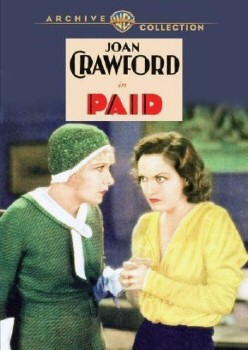 MGM. 80 minutes.
US release: 12/30/30.
MGM. 80 minutes.
US release: 12/30/30.
 Stephanie Jones
Stephanie Jones Tom
C.
Tom
C. 